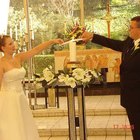
The sand ceremony, often known as the unity sand ceremony, has become a popular substitute for the unity candle during a wedding ceremony. During the unity candle ceremony, the mothers of the bride and groom each light a candle and pass it along to the bride and groom who then light the unity candle. This is symbolic of the unity of the two families and of the bride and groom's lives in marriage. Many American Christian couples have incorporated this ceremony into their weddings over the last 50 years. The sand ceremony is a substitute for the candle ceremony, ideal for outdoor or beach weddings where it is difficult to light a candle, and its origins can be traced back to Ancient Egypt.
History
No one knows exactly how this tradition started, but it is believed to be of Ancient Egyptian origin; in North America, Native Americans most likely introduced the ceremony to popular culture. It is symbolic of the way marriage makes two people inseparable and lives intermingled. The first sand ceremonies involved the bride and groom throwing a handful of sand each into the wind at the same time, combining the grains.
Materials
In a religious sand ceremony, four vases are set up on a table at the ceremony location. One of the vases should be large enough to contain the sand of the other three. One vase holds sand of one color, for the groom. Another holds sand of another color, for the bride. The third holds white sand, which will be used by the officiant to represent God and His omnipresence in the new couple's lives together. You can use sand in the same colors of your wedding theme. Alternatively, only three vases may be used, with the white sand being already placed in the bottom of the large vase. If the couple has children, the children may also have vases of sand in different colors to add to the union.
The Ceremony
The bride and the groom each take their vases of sand in hand and take turns pouring some of it into a large vase. The officiant adds some white sand. They then pour the remaining sand in their vases into the large vase simultaneously. This is symbolic of the man and woman becoming one in the Biblical sense. Alternatively, they can pour the sand out into the wind together at the same time and not use the third vase.
Readings and Music
The sand ceremony may include poems, readings or scripture read by a friend, family member or religious officiant during the pouring of the sand. Alternatively, the couple may recite a vow as they pour the sand. Music may be played during the ceremony in the background.
Church Position
Some churches prohibit sand ceremonies. The Catholic Church, for example, does not allow this ceremony because it is not part of the wedding mass. If you are having a religious ceremony, be sure to ask your officiant if you are allowed to incorporate the sand ceremony.
Related Articles

Blended Family Ceremony Ideas

Romanian Orthodox Wedding Traditions

How to Do a Salt Covenant for a Wedding ...

Mexican Catholic Wedding Traditions

How to Use a Veil & Cord in a Wedding

What Is a Commitment Ceremony?

Religious Ideas for 50th Wedding ...

Order of Events for a Non-Religious ...

30th Wedding Anniversary Gift Ideas for ...

How to Tie Handfasting Cords

The Purpose of Christening

How to Officiate a Wedding Renewal

Christian Wedding Prayers and Blessings

Swedish Wedding Gifts

Traditional Duties of a Maid of Honor ...

Japanese Engagement Customs

How to Get a Divorce in Barbados

When Do You Light the Unity Candle?

Conflict Theory & Divorce

Jewish Engagement Gifts
References
Writer Bio
Andrea Nicole has 15 years of writing experience and has written for The Age online in Australia. Her primary areas of expertise are marketing communications and travel. Nicole holds a master's degree in media and communications from Swinburne University of Technology as well as a Bachelor of Science in communications and sociology from the University of Miami.
Photo Credits
unity sand wedding ceremony image by Paul Retherford from Fotolia.com